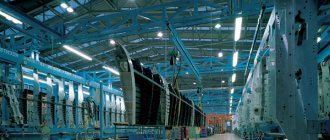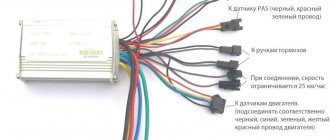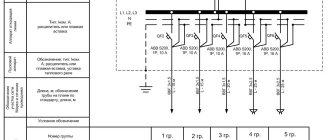Power circuit breaker The power circuit breaker protects the electrical circuit from short circuit currents and controls overloads. View catalog
Cost of the circuit breaker You can find out the current cost of power circuit breakers on the supplier’s website. View prices
Power switches High-quality power switches are distinguished by their simplicity of design, high technology, and modern design. Buy a switch
Promotions and discounts Promotions and discounts allow you to save significantly when purchasing electrical equipment. Current promotions
Purchasing electrical equipment It is worth purchasing electrical equipment from reliable suppliers with long experience and an excellent reputation. Find a supplier
The dynamism of technological processes and the natural improvement of production require flexibility, simplicity and reliability from the power supply system of modern enterprises. At the same time, industrial facilities in various sectors of the economy have their own, often unique, requirements for the design of power supply channels.
Electricity is an equal component of the production process, which means that a properly designed power supply for an industrial enterprise can significantly optimize costs and, as a result, reduce production costs.
Features of power supply to production sites
What practical principles should be followed when designing an industrial power supply system?
Simplicity and scalability. The power supply system for industrial enterprises should not be multi-stage, the supply networks should not be long, and the method of laying the network should be as simple as possible. In addition, the system must provide the ability to introduce new equipment, that is, be scalable.
No overload. When designing workshops for industrial enterprises, both the placement of equipment in the workshops and the location of transformer substations are important. If possible, each section should be provided with a separate switchgear, which is installed near the load center. Other consumers and areas should not be able to connect to this device to avoid overload.
Ensuring a smooth production process. In production facilities with parallel technological flows, the network must be built in such a way that if it is necessary to turn off one element of the network (in the event of an accident, for the purpose of repair), only those mechanisms that relate to this flow are turned off. Other process streams must remain in working order.
Safety. All electrical equipment used must have a degree of protection appropriate to the operating conditions of a particular workshop.
Important Industrial premises are divided into several hazard classes. There are rooms with explosion and fire hazardous areas, with a chemically active or organic environment. There are also dry, humid, damp, hot, dusty rooms. Recommendations on the degree of protection of electrical equipment depending on the environment are given in the Electrical Installation Rules (PUE).
If all these factors are taken into account at the system design stage, the possibility of expanding production, introducing new technologies, and using innovative equipment increases.
Cost of services for power supply of industrial facilities
| System design and approval for non-residential premises: | |
| *Premises used for office or trade, S ≤ 300 m² | 60 rub./m², but not less than 7500 rub. |
| *Premises used for office or trade S = 300 - 500 m² | 50 RUR/m² |
| *Premises used for office or trade S = 500 - 1000 m² | 40 RUR/m² |
| *Premises used for office or trade S ≥ 1000 m² | within ± 35 rub./m² |
| *Warehouse premises S ≤ 300 m² | 50 rub./m², but not less than 7500 rub. |
| *Warehouse premises S = 300 - 500 m² | 40 RUR/m² |
| *Warehouse premises S = 500 – 1000 m² | 35 RUR/m² |
| *Warehouse premises S ≥ 1000 m² | within ± 30 rub./m² |
| *Industrial and medical premises S ≤ 300 m² | 65 rubles/m², but not less than 7500 rubles. |
| *Industrial and medical premises S = 300 - 500 m² | 55 RUR/m² |
| *Industrial and medical premises S = 500 - 1000 m² | 45 RUR/m² |
| *Industrial and medical premises S ≥ 1000 m² | within ± 40 rub./m² |
| Collection, preparation and approval of project documentation: | |
| Formation of a package of documents, sending for approval to the Moscow electric grid company (technological connections department). Receiving the result in the form of technical conditions, power permission or refusal. | RUB 15,000.00 |
| Certificate from Mosenergosbyt OJSC confirming that the enterprise has no debt. | RUB 5,000.00 |
| ** Submission of documents for the purpose of preparing a situation plan | RUB 5,000.00 |
| Preparation of an act and its approval regarding the division of operational responsibility and balance sheet ownership | RUB 15,000.00 |
| Organization of accounting tools with obtaining technical specifications | RUB 5,000.00 |
| ** Obtaining approval of design documentation from the electricity transport department of the MKS branch of OJSC "MOESK" | RUB 8,000.00 |
| ** Approval of the project in Energonadzor at the territorial level | RUB 8,000.00 |
| ** Obtaining design approval from OJSC Mosenergosbyt | RUB 8,000.00 |
| **Collecting the necessary documentation and submitting it, calling an inspector to obtain permission to operate and obtain the appropriate certificate | RUB 15,000.00 |
| Execution of an agreement for the provision of energy supply services in the branch of OJSC Mosenergosbyt | RUB 20,000.00 |
| *The price includes the cost of a representative visiting to receive introductory notes and conclude a contract, as well as upon completion of the work, delivery of the finished project in Moscow. For the Moscow Ring Road, the cost of transportation costs is calculated individually. **Services of government agencies conducting approvals are not included in the price. | |
Elements of the enterprise power supply system
The main elements of the power supply system include:
- power supply;
- power lines from the power source to the enterprise;
- electrical energy collection point;
- distribution networks;
- receivers (electricity consumers).
The main components of the power supply system are the supply and distribution networks. The supply network is the lines extending from the power source to the point where electrical energy is received. Distribution networks are lines that supply electricity from receiving points directly to electrical equipment. In this case, power supply circuits can be radial, mainline or mixed. The trunk circuit involves power supply to nodes and powerful consumers via separate lines connected to the trunk at various points.
The main circuit is relevant for energy-intensive industries in mechanical and instrument engineering, non-ferrous metallurgy, and experimental production. Trunk power supply circuits for enterprises are highly reliable and are used in rooms with a normal environment and a fairly uniform distribution of equipment. Radial power supply circuits are used in rooms with any environment. With this scheme, each consumer is connected to a substation or distribution point via a separate line. With a mixed scheme, each mainline feeds a number of points, from which radial lines extend directly to receivers. Radial circuits are used to power concentrated loads and powerful electric motors.
Requirements for electrical networks of industrial facilities
In addition to the above principles of power supply to industrial enterprises (uninterruption, efficiency, flexibility, proximity to power sources, the minimum number of transformation stages, the use of reliable backbone circuits, etc.), there are also certain regulatory requirements for the electrical networks of industrial facilities.
In industrial enterprises, the power source can be an electrical station from the central power supply system or the enterprise's own station. An own power plant is necessary when there is a large energy consumption, when there are special requirements for the reliability of the power supply system, and when the enterprise is remote from the power systems.
Power supply requirements:
- At enterprises with electrical receivers of categories I and II there must be two or more independent mutually redundant power sources.
- For electrical receivers of special group I category, a third independent power source must be provided.
- Energy-intensive enterprises should be powered from the power grid at a voltage of 110 or 220 kV.
- Enterprises with a light load can operate at voltages of 6, 10 and less often 35 kV.
- At low loads, a voltage of 0.4 kV from the power grid or a neighboring enterprise is sufficient.
- The distribution network of industrial enterprises must operate at a voltage of 10 kV, in some cases - 6 kV, and for energy-intensive enterprises - at a voltage of 110 kV.
With compact placement of electricity receivers, there can be only one receiving point. Two collection points are required under the following conditions:
- if the enterprise has two or more relatively powerful separate groups of consumers;
- with increased requirements for the reliability of power supply for category I electrical receivers;
- during the phased development of the enterprise to power the second-stage loads.
The electrical requirements for various types of facilities are extensive and regulated by a large number of regulations. Regarding the power supply of industrial enterprises, the following documents can be distinguished:
- Rules for the construction of electrical installations (PUE) are a group of normative documents that are not a document in the field of standardization.
- NTP EPP-94. Technological design standards. Design of power supply for industrial enterprises.
- CH 357-77. Instructions for the design of power and lighting electrical equipment of industrial enterprises.
- SNiP 3.05.06-85. Electrical devices.
- GOST 30852.0-2002 (IEC 60079-0:1998). Interstate standard. Explosion-proof electrical equipment. Part 0. General requirements of NTP EPP 94. Design of power supply for industrial enterprises.
Electrical supply design plays a key role when commissioning industrial facilities. Any errors at the design stage in the future will lead to problems in the functioning of the entire enterprise.
Automatic switches BA57-39 NM1 TEXENERGO
Switches of the BA57-39 series are designed to conduct current in normal mode and cut off the current in case of short circuits, overloads, and unacceptable voltage drops.
From 5,269 RUR
More details
Initial data for designing power supply at enterprises
Electrical systems at production facilities are of great importance, since they power a large number of electrical devices, machines and apparatus in such structures. In a modern production enterprise, the functioning of other engineering networks necessary for the facilities can be based on the use of electricity. When designing an electrical system at an industrial facility, it is imperative to take into account the required category of power supply reliability, the number of consumers in the enterprise and their power. Particular attention should be paid to safety systems when designing, since powerful electrical systems can pose an increased danger to users and electrical devices connected to them if any problems occur.
To order a professional power supply system project, the owner of the enterprise will need to prepare initial design data containing information about the production facility, its dimensions, characteristics, operating rules, as well as the customer’s requirements for the parameters of the electrical network. Among the most important documents for design, technical specifications are often identified. A competently drawn up technical specification for the development of a power supply project for an enterprise should include the following data:
- Address of the facility, area of internal premises and workshops.
- The name of the owner of the production facility.
- The main purpose of the production enterprise.
- Reliability category of the enterprise's power supply system.
- The number of phases in the electrical wiring of the enterprise.
- The source of electricity for the engineering system is a connection to the central power grid of the city or the organization of individual power supply for a production facility.
- Requirements for backup power sources that are planned to be installed in production, installation locations of generators, their technical characteristics, fuel used, automatic switching on and off.
- The place where the internal electrical network is connected to the central power supply system.
- Places for installation of electrical distribution boards.
- Contents and connection diagrams of equipment in electrical panels, requirements for safety devices.
- Methodology for installing electrical cables and electrical consumption points in the interior of a production facility.
- Parameters, location and tasks of safety systems - grounding and lightning protection.
- A list of electrical equipment, instruments and devices that will be connected to the enterprise’s power supply system, indicating their power, installation locations and other data.
- All the customer’s requirements and wishes for the technical characteristics of the enterprise’s power supply system, the location of individual elements of the electrical network, the location of lamps and points of consumption.
The technical specification is the largest document with initial data provided to designers for the development of an electrical supply system. Specifications for electrical systems at small facilities are usually drawn up by the owner personally, while drawing up a task for designing electrical supply at a large manufacturing enterprise may require professional knowledge in the field of organizing engineering networks. Owners of enterprises can entrust the preparation of technical specifications to their employees responsible for communications at the facilities, or to hired design specialists.
In order to create a competent design of an internal electrical system connected to the central power grid of the city, the parameters of which will fully satisfy the current legislation and the requirements of operating companies, the owner must provide the designers with technical specifications for the connection.
Specifications can be issued to the owner by employees of the operating company after receiving a corresponding application from the owner of the enterprise. In order for the application to be considered and the customer to quickly receive the documents he needs, the application must be accompanied by the following documents:
- address of the object, its area and other technical characteristics;
- technical passport of the structure;
- certificate of ownership;
- estimated volume of consumption by all electrical devices of the enterprise;
- architectural drawing of the object;
- situational plan of the construction site;
- the purpose of the production enterprise and its mode of operation.
In addition, designers will need to provide professional diagrams:
- Architectural plan of a manufacturing enterprise indicating the locations of the central network input.
- Drawings and diagrams of the internal premises of the enterprise, indicating individual internal zones, workplaces, installation locations of powerful equipment and other electrical consumers.
Having all the necessary information, experienced craftsmen can complete design work as quickly and efficiently as possible. To create an electrical project for a small facility, it may take specialists only 24 hours. Creating an electrical system project at a large manufacturing enterprise is much more difficult; such work can last up to 2 weeks.
| Enterprise area | Design timeframe |
| Up to 500 sq. meters | Up to 3 working days |
| Up to 1000 sq. meters | Up to 8 working days |
| Up to 2000 sq. meters | Up to 10 working days |
| More than 2000 sq. meters | Up to 15 working days |
Design of power supply systems for industrial enterprises
When designing a power supply system, the following parameters are first determined:
- electrical loads of groups of electrical receivers, load nodes and the entire enterprise as a whole;
- structure of the power supply system - the number and location of all elements of the system;
- rational voltage of supply and distribution networks;
- method of transporting electricity in power supply and distribution networks;
- design of electrical installations and electrical equipment;
- technical means to ensure electrical safety during operation of the power supply system.
A well-executed design stage will eliminate such common problems as increased installation costs and the “creeping” of different utility networks onto each other. Careful study of project details allows us to minimize modifications during installation and integrate all engineering systems with each other.
Design and operation of power supply systems for industrial enterprises is a multifunctional and labor-intensive task. This area is constantly improving and becoming more complex due to the emergence of new technologies and equipment. Requirements for the quality of electrical energy and reliability of power supply are also increasing. To solve problems in this area, it is necessary to use computer technology, as well as high professionalism.
Engineering network design
A modern manufacturing enterprise must have many different engineering networks necessary for the comfortable operation of the facility by company employees, as well as for the correct production process and to ensure suitable storage conditions for the final product. Design should only be ordered from qualified and experienced craftsmen with extensive experience in the field.
We have been providing clients with services in the field of designing various communications for a long time. We can prepare for you a water supply project for an enterprise, a ventilation project, a sewerage project, an air conditioning project, and a heating project.
You can find out the cost of designing an electrical system with us in advance by using an automatic calculator.











